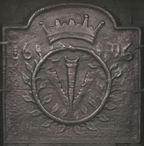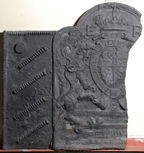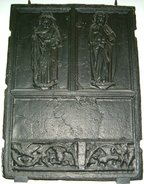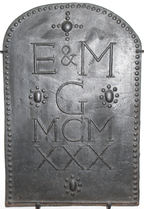-
58
Description: Arched rectangular shape; cavetto edging; a pheon (a downward-pointing arrow head barbed on the inner edge), the badge of the Sidneys, within a wreath, an earl’s coronet above; the date on either side of the coronet.
Notes: The badge is of the Sidneys, Earls of Leicester. The date is most likely to be 1626 as the Earldom was not conferred upon Robert Sidney until 1618 and he died in 1626. A recast plate.
Inscription: 16 [?]26
Arms: Badge of Sidney family, Earls of Leicester
- Decoration tags:
- rectangular with round arch (shape)
- astragal (edging)
- whole carved pattern
- individual numbers
- heraldic
- text
Manufactured: in the early- to mid-17th century possibly at Robertsbridge Furnace, Salehurst in the Weald area of England.
Current location: Florence Court, Enniskillen, Fermanagh, Northern Ireland.
Museum number: 630836 (part of the National Trust museum group)
- Attached to series:
- Earl of Leicester series
- Personal firebacks
-
403
Description: Fragment; arched rectangular shape with rounded corners; ovolo within fillet moulding all round; oval Tudor royal shield with garter surrounding, topped with a royal crown; dragon and (missing)greyhound supporters; initials split by crown; inscription on a fillet between legs of supporters, behind garter finial; motto on an Ionic plinth at bottom; rectangular side panels with twisted rope edging top and side; a short length of turned dowel stamped four times, diagonally, on each panel; a circular disc with concentric grooves in top left corner.
Notes: Similar to a fireback in the Victoria & Albert Museum, but differentiated by the twisted rope edging of the side panel and the addition of the grooved disc. The disparity between the worn surface of the armorial panel and the greater clarity of the extensions indicates that the extended casting was made using an already well-used armorial fireback and therefore at a substantially later date.
Inscription: E R / HONY SOIT QUE ... / Made in Sussex by J... / DV ET MOV...
Arms: Tudor royal - Edward VI
- Decoration tags:
- rectangular with round arch (shape)
- rope (edging)
- simple stamps
- carved stamps
- whole carved pattern
- extension panels
- armorial
- royal
- text
- objects
Manufactured: in the late-16th century in the Weald area of England.
Current location: Anne of Cleves House, Southover High Street, Lewes, East Sussex, England.
Museum number: LH000.916 (part of the Sussex Archaeological Society museum group)
- Attached to series:
- Pounsley series
- John Harvo series
- Tudor royal armorial firebacks
-
754
Description: Rectangular; flanged edging; two panels at top, each with double astragal edging, containing the figures of St James and St Peter; plain panel below with same dging; bottom panel with fillet edging containing carved stamps of scrolled foliage and beasts.
Notes: Carved religious figures are common on stove-plates.
- Decoration tags:
- rectangular (shape)
- flanged (edging)
- carved stamps
- biblical
- humans
Manufactured: in the mid- to late-16th century possibly in the Eifel area of Germany.
Current location: Victoria & Albert Museum, Cromwell Road, Kensington & Chelsea, Greater London, England.
Museum number: M.334-1940 (part of the Victoria & Albert Museum museum group)
- Attached to series:
- Stoveplates
-
774
Description: Arched shape with bead edging; from top, large bead with four pairs of small beads in a cross shape, text with pellet surrounded by eight beads on each side of 'G', and at bottom.
Notes: Made by, and bearing the initials of Eric Gill and his wife, Mary, in 1930.
Inscription: E&M / G / MCM / XXX
- Decoration tags:
- rounded arched (shape)
- bead (edging)
- whole carved pattern
- text
Manufactured: in 1930 at Loosley Row Foundry possibly in the Chilterns area of England.
Current location: Victoria & Albert Museum, Cromwell Road, Kensington & Chelsea, Greater London, England.
Museum number: M.4-1983 (part of the Victoria & Albert Museum museum group)
- Attached to series:
- Personal firebacks
- Miscellaneous stamp firebacks
-
1063
Description: Composite of three elements; central panel has a complex ‘knot’ pattern with a fillet edge; side panel, repeated on either side of the central panel, contains a vase of flowers, possibly stylised thistles, within an arched frame and fillet edge; arched panel above, also with fillet edge, contains the date and inscription; the spandrels of the side panels, and the arched top panel, contain a series of circular motifs comprising concentric rings deepening towards the centre.
Notes: ‘Knot’ patterns were popular in gardens of the period. The garden theme is continued with the side panels. An example of the same design, noted at Linchmere, West Sussex, is a different casting, the top panel with the date and initials being slightly askew. From a photograph in the Victoria and Albert Museum, London; photographed at Mapesbury House, Willesden in 1904.
Copies of this fireback are known.
Inscription: 1598 / IM IB
- Decoration tags:
- rectangular with round arch (shape)
- astragal (edging)
- carved pattern panels
- text
- plants
- objects
Manufactured: in 1598 in the Weald area of England.
Current location: not known.
Museum number: E.4376-2000 (part of the Victoria & Albert Museum museum group)
- Attached to series:
- Armada series
- Garden design types




